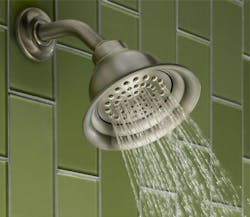Building Science: Bathroom plumbing saves energy, water, money
Fall is a popular time for bathroom remodeling projects. Before the holiday season brings guests, homeowners want their bathrooms to be bright, beautiful, and of course work well. October was Energy Action Month, but there is still an opportunity to talk to your clients about providing new plumbing that performs well and also saves water, energy and money.
Start with the EPA’s WaterSense label for plumbing products, which indicates models are independently certified for both water efficiency and performance. WaterSense labeled products are available in a wide variety of styles, colors, and price points to fit any budget or project—from a basic bathroom remodel to a custom makeover.
Bathrooms are by far the largest water users in the home, accounting for more than half of all indoor water use. When homeowners replace their existing fixtures with WaterSense labeled models, the savings can add up. Giving a home’s main bathroom a high-efficiency makeover by installing a WaterSense toilet, faucet, and showerhead can save the average family nearly 10,000 gallons of water annually, and can reduce water and electricity costs by more than $140 per year. On top of those savings, many utilities offer rebates to customers who swap out inefficient fixtures for WaterSense labeled models.
An Addition That Subtracts Utility Costs
For those customers in the market for a larger remodeling project—whether an addition with a new bathroom or a gut rehab—the possibilities for energy and water savings are even greater. In addition to suggesting water-saving fixtures, you can also recommend an efficient hot water delivery system that will increase the efficiency of the plumbing system and provide increased customer satisfaction.
As temperatures fall, homeowners have a tendency to turn on the water and wait for it to heat up. This is a waste of water, energy, and money. As hot water travels through pipes to the point of use, it loses heat, as it does when it sits for hours in the tank or pipes before it is used. Plumbing systems waste both energy and water when hot water moves through pipes that take circuitous routes, have a larger diameter than is necessary, or have excessively long runs—a common problem in today’s larger homes.
Hot water delivery plays such a large role in household water and energy use that EPA’s specification for new homes to earn the WaterSense label requires an efficient water delivery system. To minimize water loss and maximize efficiency, the plumbing system in a WaterSense labeled home can store no more than 0.5 gallons of water between the hot water source (typically the water heater but this can also be the recirculation line) and any hot water fixture. In addition, any recirculation system must be demand-initiated, drawing hot water into the recirculation loop only when needed.
Before embarking on a major remodel or breaking ground on a full addition, enlist a plumber to help you install an efficient hot water delivery system that performs well. WaterSense has
created the Guide for Efficient Hot Water Delivery Systems to help remodelers and plumbers better understand and implement efficient plumbing system designs. Working together early in the design phase helps ensure a direct route and gets hot water to its destination faster.
For more information about remodeling with WaterSense labeled plumbing products, visit www.epa.gov/watersense/products. PR
